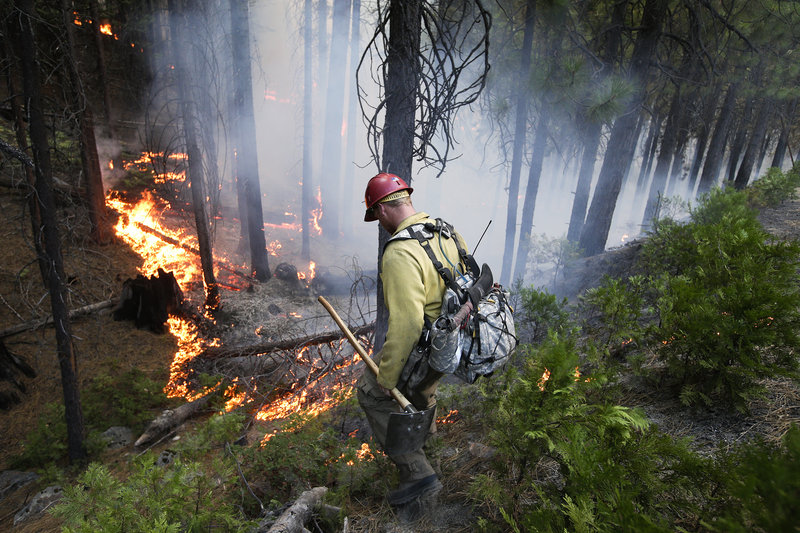GROVELAND, Calif. – As the massive Rim fire roared out of the Stanislaus National Forest and deeper into Yosemite National Park this week, public attention rose sharply.
But the intensity of firefighting did not.
That’s because part of the blaze had crossed into the jurisdiction of the National Park Service, which has a more restrained approach to managing wildfires than other federal, state and local fire agencies battling the 300-square-mile blaze.
Officials estimate that it will be fully contained in two or three weeks, but it is expected to keep smoldering for weeks longer and won’t be truly out for months.
“This fire will burn until the first rains or until the snow flies,” said Lee Bentley, a spokesman for the U.S. Forest Service.
Although the 4,900 firefighters here operate under a unified command, the park service has a very different firefighting philosophy from that of the forest service or the California Department of Forestry and Fire Protection.
The portion of the Rim fire burning outside the park is fought aggressively by the forest service and Cal Fire. Bulldozers rip fire lines across the landscape, and crews fell trees and set protective backfires. Helicopters and tanker airplanes drop water and retardant.
“We want to send as much equipment to a fire as we can,” said Cal Fire spokesman Daniel Berlant. “Our goal is to put it out early and avoid having a large fire.”
But inside parks, a policy often called “fire use” accepts fire as a naturally occurring process and often a useful tool.
Park fire managers suppress blazes that endanger people or threaten structures and resources. Fires in tourist-heavy Yosemite Valley, for instance, are “very, very controlled,” said Tom Medema, Yosemite’s chief of interpretation and education.
Otherwise, park officials prefer to herd fires where they want them to go and allow blazes to burn out on their own.
It’s a science-based approach that serves the same function as off-season forest thinning and controlled burns. But those arguments often fail to stand up to public distaste for trees burning in beloved national parks.
“People will say, ‘I’ve planned my whole life for a trip to Yosemite and I can’t even see Half Dome,”‘ Medema said. “I totally understand that.”
Public perception is fed by a belief widely held in the 1940s, ’50s and ’60s that fire is bad, period. The park service has worked hard to change that perception, and Medema said the agency has made progress.
As the Rim fire invades Yosemite, park officials will pore over maps that reflect the historic fire return interval — the frequency that natural fire goes through an area. Every acre of the park is mapped in this fashion, and each has a fire “prescription.”
So, for instance, when the blaze hits an area of the park where fire returns every 12 years — but hasn’t been burned in 16 years — the prescription for that area is to let it burn.
The park service’s distinction between natural and human-caused fires is not one that other agencies make.
Send questions/comments to the editors.



Success. Please wait for the page to reload. If the page does not reload within 5 seconds, please refresh the page.
Enter your email and password to access comments.
Hi, to comment on stories you must . This profile is in addition to your subscription and website login.
Already have a commenting profile? .
Invalid username/password.
Please check your email to confirm and complete your registration.
Only subscribers are eligible to post comments. Please subscribe or login first for digital access. Here’s why.
Use the form below to reset your password. When you've submitted your account email, we will send an email with a reset code.